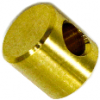Some things to consider which may help
Air bubbles
If you are using a vacuum pump, sucking air is a common issue. It doesn't suck air into the hydraulic system, but It sucks air from the outside world and past the threads of the bleed valve, and into the tube as the fluid emerges. PTFE tape wrapped around the threads helps to reduce this, but it is difficult to eliminate. It tends to be a steady stream of small bubbles. I use a vacuum pump, but always finish off with the teaditional method, with the help of a non return bleed valve in the tube.
If you are bleeding using the traditional pump the lever technique - there is nowhere for air to get into the system, fluid and air is being pushed out, not sucking in, so the bubbles must be air in the lines or the slave. Keep bleeding.
Fluid Leak
Does pumping the lever result in more bfluid coming out of the weep hole ? If so, your seal on the piston is shot, or it has inverted. When I did mine, I found that both seals had turned to a thick black paste. They scraped off like butter from the fridge! The bike had 28000 miles on it and was 4 years old, and had been sitting for a while, unused.
Clutch lever
Oh, one other thing. When I first test rode the bike, the clutch didn't engage until nearly all the way out.
If the clutch didn't engage until the last part of the stroke of the lever - that sounds like the push rod in the clutch lever is not seated properly inside the hole in the bush in the lever. Remove the locknut on the clutch lever, and then unscrew and remove the pivot bolt. As you remove the clutch lever, hold the brass bush in position. nb - your bush may not be brass.


The diagram shows the part of the master cylinder internals. #1 is the pushrod which emerges from the rubber boot, both of which you can see once the lever is removed. #2 is the brass bush that slots into a hole in the clutch lever. The hole in the side of the bush is drawn in the diagram, but it is a blind hole. It doesn't go all of the way through. It looks like the image on the right. The end of the pushrod MUST fit inside that hole - so the diagram is drawn so you can see the hole, but in fact it should be turned 180 degrees to face the pushrod. If it doesn't, the pushrod will always be putting pressure in the slave piston and it will never properly engage. It will only start to bite at the end of its stroke as you release the lever - which is what you described. If you hold the bush in position as you remove the lever, you will be able to tell if this was your problem.
Anyway, take it out, clean it up and on the circular end of the bush, with a felt pen, draw a line to the edge to indicate the direction of the hole. A smear of grease in the hole and bush (rubber grease if you have it, but otherwise normal grease, but you dint want it to cine into contact with the rubber boot. Put it back into the clutch lever, with the circular face with your line on it facing up. Rotate it so that the hole is facing towards the plunger check the hole visually, and check your line. Then offer the lever assembly to the bracket and ensure the pushrod goes into the hole. You cant see it, so you have to feel it. If you are not sure, try doing it with the hole facing the wrong way first, so that you know what it feels like when it is wrong.
Insert the pivot bolt. Just snug it up. I think it is 2nm, but check that figure. It is not a clamping bolt. Put the locknut on the underside and tighten that to the correct torque while holding the pivot bolt with a screwdriver.



